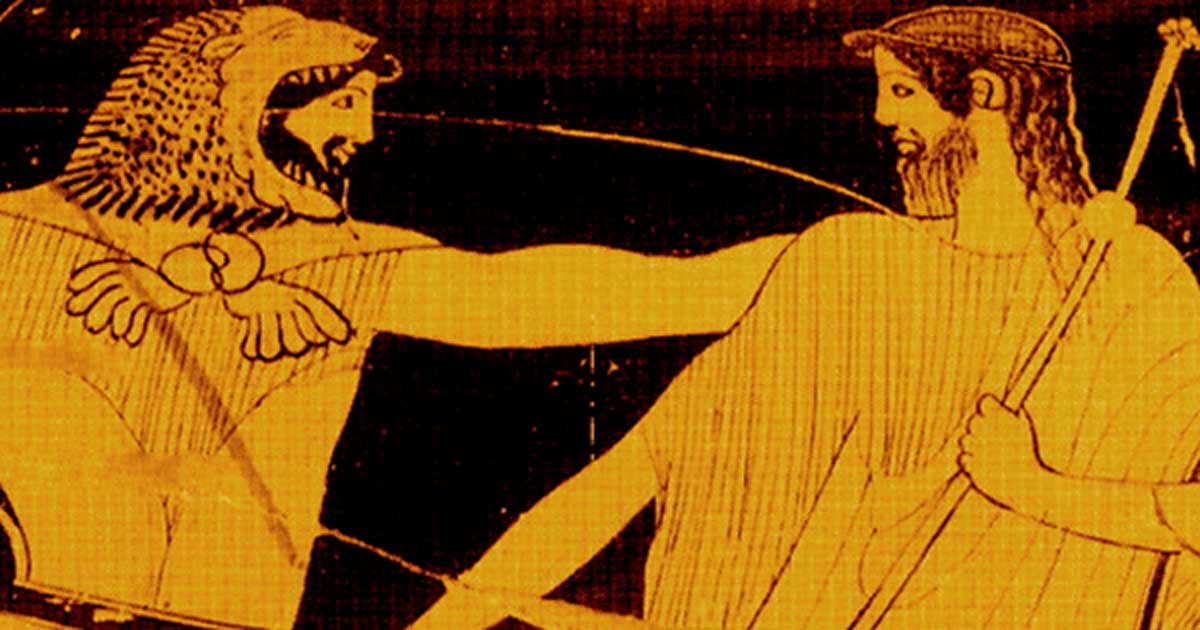Ancient Greek Vase Artists Painted Images of Biblical Figures Noah and Nimrod Over 2,000 Years Ago
The Book of Genesis describes human history. Ancient Greek religious art depicts human history. While their viewpoints are opposite, the recounted events and characters match each other in convincing detail. This brief article focuses on how Greek religious art portrayed Noah, and how it portrayed Nimrod in his successful rebellion against Noah’s authority.
As I point out in my new full-color book, Genesis Characters and Events in Ancient Greek Art, and here, neither Noah nor Nimrod is depicted incidentally or casually. Both characters are crucial to the expressed boast of Zeus-religion: The way of Cain—the exaltation of mankind as the measure of all things—has triumphed over Noah and his God-fearing offspring in the post-Flood world; God’s way is forgotten and the ancient serpent’s “enlightenment” from the ancient garden paradise is welcomed. See: Garden of Eden Depicted in Ancient Greek Religious Art
Unless otherwise noted, the paintings and sculptures date from about 440 to 460 BC. Astounding is not a strong enough word for what is presented here: Painted and sculpted images of Noah and Nimrod from two and a half millennia ago!
It should be front page news, but as it does not fit within the ruling evolutionist paradigm, it will most likely be ignored. Let’s see what happens.
- Garden of Eden Depicted in Ancient Greek Religious Art
- Startling Similarity between Hindu Flood Legend of Manu and the Biblical Account of Noah

Ancient vase images of Noah/Nereus. (Author provided)
Nereus—The Greek Noah
The Greeks knew exactly who Noah was. They called him Nereus, the “Wet One,” and Halios Geron, the “Salt-Sea Old Man.” Above, we see three different depictions of Nereus from ancient Greek vases. On all three he looks very old, he is seated as if on a throne, and he holds a scepter, a symbol of rule. The simple artistic communication: Here is the old man who ruled.
Genesis 6:9 speaks highly of Noah’s character: “Noah is a just man. Flawless became he in his generations. With God walks Noah.”
The ancient Greek poet Hesiod says essentially the same thing about Nereus: “But Pontos, the great sea, was father of truthful Nereus who tells no lies, eldest of his sons. They call him the Old Gentleman because he is trustworthy, and gentle, and never forgetful of what is right, but the thoughts of his mind are mild and righteous”
(Theogony 233).
Note that Hesiod describes Nereus as the great sea’s eldest son; that is, the eldest of those who came through the Flood.
The Book of Genesis does not name Noah’s wife, but the Greeks said that the wife of Nereus was the Oceanid Doris. What made her an Oceanid was the fact that she rode the ocean in the ark with Noah/Nereus and their family for nearly a year.
Greek artists chronicled the rise of their God-rejecting and serpent-exalting religion from Noah’s lifetime, and often depicted Noah/Nereus with the bottom half of a fish and/or holding a fish, signifying that this is the fish-man who brought humanity through the Flood.
Herakles—The Greek Nimrod
The Greeks knew exactly who Nimrod was as well. Many of us have read of Nimrod as “a mighty warrior on the earth” and a “mighty hunter” (Genesis 10:8-9). Herakles is a title or epithet. His real name in Greek was Alcaeus meaning “mighty one.”
Just as Nimrod is the greatest hunter and warrior of the post-Flood world in Genesis, so Herakles is the greatest hunter and warrior in Greek religious art. Herakles is the Nimrod of Genesis, exalted as a great hero and transported to Greek soil.
After the Flood, God instructed mankind to be “fruitful and increase and fill the earth and subdue it” (Genesis 9:1). That included subjecting every living animal of the earth, all the fishes of the sea, and every flyer of the heavens (Genesis 9:2-3). Greek art portrayed Herakles as the “master hunter” doing exactly that in the post-Flood world.

First three labors of Herakles from the Temple of Zeus at Olympia as they originally appeared in color. They correspond to God’s instructions in Genesis for mankind to subject every land animal, water creature, and flyer of the heavens. (Author provided)
The first three labors of Nimrod/Herakles, reconstructed above by Holmes Bryant as they appeared on the temple of Zeus at Olympia, boast of his conquest of the most powerful animals of the land, water, and air: the lion of Nemea, the fearsome Hydra of Lerna, and the vicious man-attacking birds of Lake Stymphalos.
Athena accompanied him on all three of these labors although the sculptors had no room for her in their depiction of him killing the water monster. See [LINK TO: . . . “THE HIDDEN IDENTITY OF THE WOMAN GLORIFIED AS ATHENA: HER LINK TO THE PRE-FLOOD WORLD”]
While appearing to carry out God’s instructions, Nimrod/Herakles violates them in the most egregious way possible. He takes the mandate recorded in Genesis, and changes its orientation away from reverence for Noah’s God and instead turns it toward the exaltation of himself and mankind.
The Targum of Jonathan says: "From the foundation of the world none was ever found like Nimrod, powerful in hunting, and in rebellions against the Lord."
Nimrod/Herakles Usurps the Authority of Noah/Nereus
Nimrod/Herakles began his serpent- and mankind-exalting rebellion by nullifying the authority of Noah. The prophet of God who brought humanity through the Flood had to be pushed out of the picture, and his rule brought to an end.

Nimrod/Herakles knocks Noah/Nereus aside, usurping his authority. (Author provided)
Above, on a red-figure bobbin (a spool used in weaving), Nimrod/Herakles knocks Noah/Nereus, who holds the scepter of rule, out of the way, invalidating his authority and replacing it with his own. Herakles wears his lion head and carries his club as signs of his great prowess. He forces Noah/Nereus to drop the fish, a sign of his now disrupted authority in connection with the Flood.
- Dead Seas Scrolls Reveal that Noah's Ark Was Shaped Like a Pyramid
- Evidence of The Great Flood – Real or a Myth? Part I

Nimrod/Herakles surprises Noah/Nereus from behind, grabbing him by the shoulder and by the wrist that holds his scepter, letting him know that his authority in the post-Flood world has come to an end. (Author provided)
In the magnificent red-figure depiction above, Nimrod/Herakles, wearing his full lion skin, comes at Noah/Nereus from behind, stopping him by grabbing the wrist of the hand that holds his scepter, a symbol of his rule. Nimrod/Herakles is taking over. Zeus-religion is on the ascendant.

Wielding his club in a threatening manner, Nimrod/Herakles chases Noah/Nereus out of the way as if he were an outdated relic of the past who ought to be ignored. (Author provided)
On the vase-scene, above, Nimrod/Herakles chases after Noah/Nereus, pointing to his club, a symbol of his strength. Nereus backs up, reacting to the aggressive body language of Nimrod/Herakles. The artist’s message is simple: Nimrod/Herakles is telling Noah/Nereus to back off and stay out of the way.
Note that the serpent coils itself into the belt of Nimrod/Herakles. This tells us that the serpent is intricately related to this takeover. The weaponless Nereus does not fight back; he always remains passive, stoic even, in the face of this great post-Flood religious transformation.

Two similar vase-scenes from about 550 BC depict Nimrod/Herakles knocking Noah/Nereus out of the way. (Author provided).
On the two similar vase-scenes above, Nimrod/Herakles knocks a surprised and unresisting Noah/Nereus out of the way. Greek artists never depicted Herakles as physically harming Nereus in any way, but always as either pushing him out of the way or stopping him.
- Ancient Post-Flood History: Historical Documents That Point to Biblical Creation
- Divine, Forbidden and Dangerous? Magic Apples in Ancient Mythology

Noah/Nereus objects to the ransacking of his “house” by Nimrod/Herakles. (Author provided)
On the above vase-depiction, Nimrod/Herakles ransacks the house of Noah/Nereus, as the latter begs him to stop. The scene is figurative. Nimrod/Herakles is not destroying the physical house of Noah/Nereus. He is abrogating the authority of the ruling house of Noah/Nereus and replacing it with the rule of his house, a rule which extended well into the Roman Empire.
The world conqueror, Alexander the Great (356 – 323 BC), claimed descent—and the right to rule mankind—from Nimrod/Herakles. Most of the coins he minted depicted Herakles.

The Roman Emperor Commodus depicting himself as a ruler with the strength and authority of Herakles. (Author provided).
The Roman Emperor, Commodus, during his reign (180 – 192 AD), went so far as having his torso sculpted as Herakles (the Roman Hercules). He wears the lion head, wields the club, and in his left hand, he holds the apples—the ones Herakles had figuratively obtained from the serpent-entwined apple tree in the ancient garden once Noah/Nereus was out of the way and his rebellion complete.
Possession of the apples signified that Noah and his God no longer exercised authority, and that humanity was now back to the way it lived before the Flood—absent God and in accord with the “enlightenment” of the Genesis serpent.
It’s time to stop trivializing ancient Greek religious art as myth. It depicts the history of our race from the mankind-exalting side, and at the same time, validates the truth of the early chapters of Genesis.
While the Book of Genesis describes the early events and people in the history of mankind, ancient Greek religious art depicts those same events and people but from the standpoint that the serpent enlightened, rather than deluded the first couple in paradise. Genesis and ancient Greek religious art are opposite sides of the same historical coin. It’s as simple as that.
Top Image: A vase-scene from about 410 BC. Nimrod/Herakles, wearing his fearsome lion skin headdress, spins Noah/Nereus around and looks him straight in the eye. Noah gets the message and grimaces, grasping his scepter, a symbol of his rule - soon to be displaced in the post-Flood world by Nimrod/Herakles, whose visage reveals a stern smirk.
Robert Bowie Johnson, Jr. is the author of The Parthenon Code: Mankind’s History in Marble (translated into French and Greek) and Noah in Ancient Greek Art. His latest book is the full-color Genesis Characters and Events in Ancient Greek Art. www.genesisingreekart.com

















